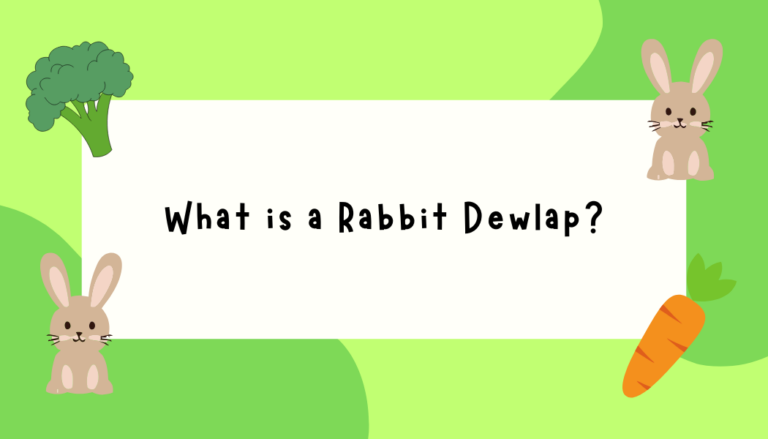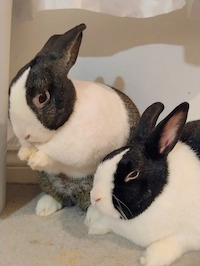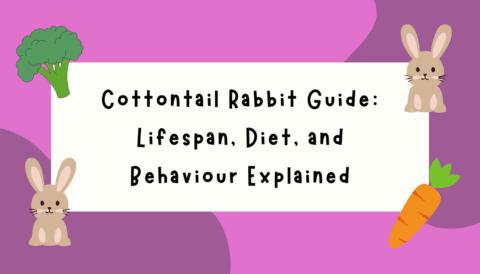Table of Contents
- What Is a Dewlap in Rabbits?
- Why Do Rabbits Get a Dewlap?
- At What Age Do Rabbits Grow a Dewlap?
- Can Spaying or Neutering Prevent Rabbit Dewlap Growth?
- Is My Rabbit’s Dewlap Normal?
- Prevent Wet Dewlap
- Can a Rabbit Dewlap Be Dangerous?
- Which Rabbit Breeds Are More Likely to Develop Dewlaps?
- Final Thoughts
What Is a Dewlap in Rabbits? Bunny Chin Folds Explained
A dewlap is a fold of fatty tissue located under a rabbit’s chin. It’s typically more pronounced in unspayed female rabbits, larger breeds and rabbits with hormonal changes. Covered in soft fur, it can look like a small pillow or fluffy pouch. While it may resemble a double chin, it often serves a purpose – especially in female rabbits.
Some rabbits develop a large one, others barely at all. Factors such as breed, gender, age, weight and diet influence the size and shape of the dewlap.
A healthy dewlap should be proportionate to your rabbit’s size and should not interfere with their ability to eat, groom or move comfortably.
Why Do Rabbits Get a Dewlap? Causes, Hormones, and Nesting Behaviour
In unspayed female rabbits, the dewlap has a biological function – nest building. When preparing to give birth, a female rabbit (doe) often pulls fur from her dewlap to line a soft, warm nest for her baby bunnies. This nesting behaviour may even occur during false pregnancies caused by hormonal shifts.
To support this instinct, providing a rabbit nesting box can offer a safe, cosy space for your doe to build her nest. A nesting box not only mimics the security of a natural burrow but also helps contain the fur and nesting materials, keeping the area clean and comfortable.
However, excessive fur pulling may indicate stress or skin irritation. Providing a calm environment, a balanced rabbit diet rich in fibre, and regular check-ups with a rabbit-savvy vet can help prevent unnecessary fur pulling.
Male rabbits don’t usually have large dewlaps unless they are overweight or belong to breeds like lop-eared or giant breeds.
Leo’s double chin appeared after a winter of a few too many treats and not enough playtime. I’m keeping an eye on his chin pouch as part of his rabbit weight management plan and ensuring he has a high-fibre timothy hay diet and more enrichment in his routine.

At What Age Do Rabbits Grow a Dewlap? Breed, Gender & Growth Factors
Rabbits don’t have dewlaps from birth. Rabbits begin developing dewlaps as they reach sexual maturity, usually between 4 to 6 months old. This may continue to grow until the rabbit is around a year old. The size and shape of the dewlap will depend on:
- Breed (giants and lops are more prone)
- Gender
- Hormonal changes
- Weight and body condition
- Diet and nutrition
- Whether they’re spayed or neutered
Want to know what 6 months means in human years?
Check out Rabbit Years to Human Years for a simple breakdown of bunny life stages – from baby to senior.

Can Spaying or Neutering Prevent Rabbit Dewlap Growth?
Yes, especially in females. Spaying a female rabbit before full hormonal maturity can significantly reduce or prevent dewlap development. Unspayed does are far more likely to develop larger, fluffier dewlaps and to engage in nesting behaviour.
In males, neutering doesn’t have a major impact on rabbit dewlap size unless the rabbit is overweight. A well-balanced rabbit food plan and proper exercise can prevent unnecessary fat deposits under the chin.
My go-to for hay-based enrichment? This rabbit play tunnel keeps Leo active and nibbling, which helps with weight control and reduces his chin size naturally.

Is My Rabbit’s Chin Normal or a Sign of Obesity?
If your rabbit has a large dewlap – especially if they’re male or a breed not prone to them – it could be a sign of rabbit obesity. Fat-based dewlaps can cause grooming difficulties, matted fur, or even moist dermatitis (commonly called wet dewlap in rabbits).
If your rabbit’s chin looks out of proportion to your rabbit’s body, consider revisiting their nutrition.
After Leo’s dewlap started to get a bit too fluffy, I switched him to a high-fibre Timothy hay diet in his hay rack, reduced sugary treats, introduced quality rabbit pellets, and encouraged physical activity with toys and tunnels. The change was noticeable – not only did his double chin reduce, but he had more energy and better digestion.

How to Groom and Care for Your Rabbit – Prevent Wet Dewlap
Rabbits with larger dewlaps may have trouble grooming underneath them, increasing the risk of:
- Matted fur
- Moist dermatitis (wet dewlap)
- Skin irritation or infection
Wet dewlap often occurs when water, saliva, or food keeps the fur damp. It’s more common in rabbits that drink from bowls, dribble while drinking, or have dental issues.
To prevent dewlap issues:
- Use a non-drip rabbit water bottle instead of a bowl to avoid wet fur and prevent chin dribbling
- Gently clean their chin with a soft, damp cloth if needed (This one has a cute bunny design!)
- Brush your rabbit regularly with a gentle grooming brush. The Hair Buster Comb gets brilliant reviews
- Provide a balanced diet with plenty of high-fibre timothy hay in a rabbit-safe hay feeder, to support digestion and a healthy weight
- Keep their living space dry and clean. I recommend this rabbit-safe disinfecting spray.
Can a Rabbit Dewlap Be Dangerous? Signs of Infection or Health Problems
While most dewlaps are completely harmless, it’s important to monitor for any sudden changes. Any rapid changes in size, shape or appearance may signal a problem. Watch for:
- Swelling, abscess or hard lumps
- Red, irritated, or moist skin under the chin
- Bad smells, sticky fur, or discharge
- Loss of appetite or grooming issues
- Excessive licking or scratching of the area
If any of these symptoms appear, consult a rabbit-savvy veterinarian. In rare cases, dewlap reduction surgery may be recommended if this is causing significant health problems and affecting the rabbit’s quality of life.
Which Rabbit Breeds Are More Likely to Develop Dewlaps?
Some breeds are more prone to developing a prominent rabbit chin fold, including:
Breeds that typically have smaller or no dewlap include:

Final Thoughts – What I Learned from My Bunny, Leo
Whether your rabbit has a small tuft or a full chin cushion, a dewlap is often just a natural part of rabbit anatomy – especially in certain breeds or unspayed females. Monitoring it’s size, maintaining grooming routines, and offering a hay-rich diet ensures your bunny stays comfortable, clean, and healthy.
Leo’s fluffy fold inspired this post – and helped me become a more attentive rabbit owner. Caring for him taught me about the importance of diet, grooming, and exercise in rabbit health.
If you’re unsure whether your rabbit’s chin is normal, too large, or uncomfortable, reach out to a rabbit-savvy vet. A little proactive care can prevent major health issues – and your bunny will thank you with happy hops and binkies!





